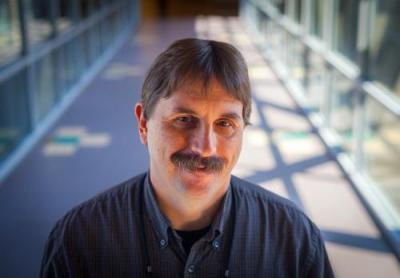SCS Rewards HCII Team for Research Excellence

Tinker Toys line the shelves of HCII Professor Scott Hudson's office, joined by electronic gadgets and gizmos of all kinds. A few felt teddy bears created on a 3D printer hang out on a couch. This is the office of a builder and inventor.
It's no wonder, then, that in the past decade he and his students have created a host of technologies that changed how humans interact with computers, bringing them out of the box and into the physical world through tools and technologies that we can touch and see. And it's also no wonder that the groundbreaking work they've performed together should receive the School of Computer Science's 2015 Allen Newell Award for Research Excellence.
The award recognizes an outstanding body of work that epitomizes Allen Newell's research style as expressed in his words: "Good science responds to real phenomena or real problems. Good science is in the details. Good science makes a difference."
In this case, that work is the "innovative and practical physical interaction techniques" that Hudson developed with former Ph.D. students James Fogarty, Daniel Avrahami, Johnny Lee and Chris Harrison, and current Ph.D. student Robert Xiao.
"The Newell Award committee was impressed with the highly innovative and deep contributions to user interface design made by this team over a decade-long period. Their work spans the full spectrum of research in this space, with a high degree of originality in every aspect," said Mahadev Satyanarayanan, Carnegie Group Professor of Computer Science and chair of the awards committee. "It includes devices, interaction techniques, statistical models, algorithms, applications and toolkits. Their work has had substantial impact on academic research as well as industry practice."
That work includes more than 25 papers outlining technologies that run the gamut from sensors on your basement's water pipes that "listen" to what's going on in your house to new fabrication technologies like 3D printing. In between lie technologies that print actual objects with fabric, use printed optics to produce curved touch displays, enhance how we interact with touch devices by sensing how we tap the screen, extend the surface of small mobile devices by creating "buttons" on flat surfaces like a desk or our skin, investigate the best locations for wearable displays, create mobile devices that sense where they’re located on your body, track motion quickly and precisely, and much much more.
"My passion has always been to build things," Hudson said, "Early in my career, almost all of my work was in software, because there was this recognition that it was the most malleable building material that humans have ever created. But over time, my original base motivations for wanting to build things dragged me back into the physical world."
His students have also gone on to create things in the physical world. Avrahami, now a senior research scientist at FXPAL, works in ubiquitous computing, mixed media and context-aware applications. Fogarty is an associate professor at the University of Washington, where he investigates new approaches to the human obstacles surrounding widespread everyday adoption of ubiquitous sensing and intelligent computing technologies. Harrison, an assistant professor in CMU's HCII, continues to work with Hudson and others to create novel sensing and interface technologies that foster powerful and natural interactions between humans and computers. Lee, now a technical program lead at Google, worked for Microsoft and helped launch the company's Kinect technology. Xiao, a fourth-year Ph.D. student in the HCII, investigates novel input devices for mobile technology.
"Scott Hudson has been a leading researcher in human-computer interaction for nearly 30 years, and the work he has done with his students has played a huge role in attracting talent to Carnegie Mellon — myself included," said Anind Dey, the Charles M. Geschke Chair and director of the HCII. "The HCII is incredibly proud of these researchers and the impact their work has had in academia and in industry."
"My current and former students being recognized by this award are great students," Hudson said. "I've been fortunate to have really outstanding students over a long period of time and they've always made a huge contribution. I think that's one of the things that makes Carnegie Mellon special — our ability to attract and work with fantastic students."
Together, Hudson and those fantastic students have done work that responds to real problems. That focuses on the details. That makes a difference.
Allen Newell would call it good science.

